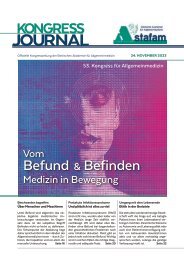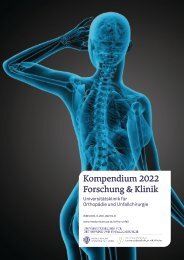Kompendium 2020 Forschung & Klinik
Das Kompendium 2020 der Universitätsklinik für Orthopädie und Unfallchirurgie von MedUni Wien und AKH Wien (o. Univ.-Prof. R. Windhager) stellt einen umfassenden Überblick über die medizinsichen Leistungen und auch die umfangreichen Forschungsfelder dar. Die Veröffentlichungen zeigen die klinische Relevanz und innovative Ansätze der einzelnen Forschungsrichtungen. Herausgeber: Universitätsklinik für Orthopädie und Unfallchirurgie MedUni Wien und AKH Wien Prof. Dr. R. Windhager ISBN 978-3-200-07715-7
Das Kompendium 2020 der Universitätsklinik für Orthopädie und Unfallchirurgie von MedUni Wien und AKH Wien (o. Univ.-Prof. R. Windhager) stellt einen umfassenden Überblick über die medizinsichen Leistungen und auch die umfangreichen Forschungsfelder dar. Die Veröffentlichungen zeigen die klinische Relevanz und innovative Ansätze der einzelnen Forschungsrichtungen.
Herausgeber: Universitätsklinik für Orthopädie und Unfallchirurgie
MedUni Wien und AKH Wien
Prof. Dr. R. Windhager
ISBN 978-3-200-07715-7
Create successful ePaper yourself
Turn your PDF publications into a flip-book with our unique Google optimized e-Paper software.
TOP-Studien<br />
63<br />
Figure 1: Biomechanical test setup: The potted fifth<br />
metatarsal specimen was fixed into a machine vice<br />
on an adjustable platform. A metal rod attached to<br />
the loading frame was used for force transmission<br />
in a plantar to dorsal direction. Light-reflecting<br />
hemispherical markers were glued onto the distal<br />
part of the Jones fracture specimen and onto the<br />
pot and rod for kinematic tracking.<br />
„To seek clarification in the biomechanical<br />
aspects of recent screw<br />
designs regarding the treatment of<br />
Jones fractures, this study compares<br />
a solid, fracture-specific screw with<br />
a cannulated headless compression<br />
screw in a biomechanical Jones<br />
fracture fixation model.“<br />
Madeleine Willegger<br />
(Jones Screw; Arthrex Inc., Naples FL, USA) (JFXS group) and the contralateral<br />
foot was assigned to conventional cannulated headless compression<br />
screw fixation (HCS; DePuySynthes, Solothurn, Switzerland) (HCS group),<br />
with equal numbers of right and left feet in each group. The fifth metatarsals<br />
were further dissected and disarticulated from the feet. Jones fractures at<br />
the meta-diaphyseal junction were created using an oscillating saw. Both<br />
screw types were inserted according to the manufacturer’s instructions. The<br />
intramedullary screw had to „fit and fill“ the medullary canal with the threads<br />
across the fracture site. HCS were available in diameters 4.5-mm and 6.5-<br />
mm, and Jones Screws were used in diameters 4.5-mm and 6.0-mm.<br />
An experimental setup was designed to simulate the postoperative in vivo<br />
loading conditions after surgical Jones fracture treatment. The specimens<br />
of the fifth metatarsal were placed with their proximal aspects in Wood’s<br />
metal in specially fabricated custom-made steel cups, which were fixed<br />
in a machine vice. The biomechanical testing was performed with an 858<br />
Mini Bionix ® (MTS ® Systems Corporation, Eden Prairie, MN). (Figure 1) A<br />
metal rod was used for force transmission onto the plantar aspect of the<br />
metatarsal head. An opto-electronic motion capture system (Smart-E; BTS<br />
Bioengineering, Milan, Italy) with four cameras was used during the loading<br />
process to track kinematic changes. Specimens were loaded with a cyclic<br />
load mean of 12 N at 0.5 Hz for 1000 cycles. The number of load cycles<br />
was chosen based on the loading rate for a physiologically normal lower<br />
limb, which is approximately 5000 cycles per day. One thousand cycles per<br />
day were assumed to realistically simulate post-operative loading during
















